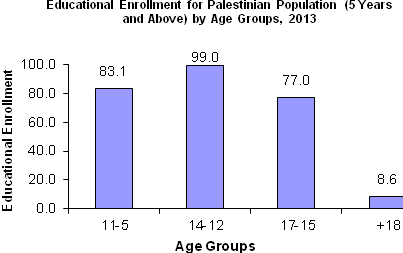Palestinian Central Bureau of Statistics (PCBS)
Press Release
Social Survey of Jerusalem Governorate, 2013
Jerusalem's Population is one Tenth Population of Palestine
The total population of Jerusalem governorate in mid-2013 was estimated at 404,165 persons, of whom 251,043 were in Area J1 and 153,122 were in Area J2. The population in Jerusalem governorate constitutes 9.1% of the total population of Palestine and 14.9% of the population in the West Bank.
Palestinian Society in Jerusalem Governorate Youthful Society
The percentage of persons aged below 15 years in 2013 was 35.2% of the total population, while those aged 60 years and above made up 6.7% of the total population in Jerusalem governorate.
3.9% Illiteracy Rate in Jerusalem Governorate
The illiteracy rate in Jerusalem governorate was 3.9% of all individuals aged 10 years and above.

Density Housing in Jerusalem Governorate 1.5 Person Per Room
The average number of rooms per housing unit in Jerusalem governorate was 3.7 rooms. The average housing density in Jerusalem governorate was 1.5 persons per room.
Three-quarters of Individuals Use Computer
Around 75.0% of individuals aged 5 years and above use a computer, 67.9% individuals aged 5 years and above use the Internet, and 70.6% own a mobile phone.
Nine Out of Ten Jerusalemites Are Covered by Health Insurance
Around 92.4% of individuals in Jerusalem governorate reported having some kind of health insurance (97.1% in Area J1 and 84.8% in Area J2). In J1, 95.5% reported using Israeli insurance (Kupat Holim/health funds) compared to 6.6% in Area J2.
Majority of Jerusalem's population suffers from Arnona tax
Around 52.6% of Palestinian households in Jerusalem governorate pay arnona tax (80.3% in Area J1 and 5.0% in Area J2).
Expansion and Annexation Wall
56.5% of the population of Jerusalem governorate were live inside the expansion and annexation wall. Also, 37.9% of Palestinians were forced to go to the other side of the expansion and annexation wall for reasons of tourism or cultural and entertainment activities, 30.1% to visit relatives, 14.3% for health care, 2.0% for work, 1.5% to follow up with departments supplying services, 0.6% for education, and 0.4% for other services. Movement between both sides of the expansion and annexation wall is a regular daily practice and is not related to any particular reference period.
Jerusalem Area J1:
Includes that part of Jerusalem which was annexed forcefully by Israel following its occupation of the West Bank in 1967.
Jerusalem Area J2:
Includes the remaining parts of Jerusalem governorate.
"Data collection of Social Survey of Jerusalem Governorate, 2013was funded by the European Union"
 عربي
عربي